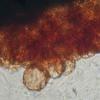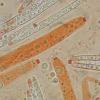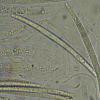
07-01-2026 10:24
 Danny Newman
Danny Newman
Pezicula sp. on indet. hardwood Appalachian Highl

07-01-2026 10:05
 Danny Newman
Danny Newman
cf. Chaetospermum on XylariaCosby Campground, Grea

02-01-2026 17:43
MARICEL PATINOHi there, although I couldn't see the fruitbody, I

04-01-2026 17:45
 Stephen Martin Mifsud
Stephen Martin Mifsud
I was happy to find these orange asmocyetes which

03-01-2026 13:08
Niek SchrierHi all,We found groups of perithecia on a Lecanora

29-12-2025 17:44
Isabelle CharissouBonjour,J'aimerais savoir si d'autres personnes au
One more collection where I could need some help:
Substrate: Strongly decayed coniferous wood
Description:
Perithecia superficial on wood, nearly globose, diameter 0.4-0.5 mm, with a short ostiolar neck of 40-50 µm on top. Perithecial wall dark brown tob lack, slightly rough.
Perithecial surface consisting of brown, globose, rough-walled cells of 15-20 µm in diameter.
Perithecial content reddish. Asci 8 spored, IKI negative, CR positive, 200-250 x 12-13 µm. Spores hyaline to very slightly coloured, 8-11 septate but probably mostly 10 septate (not always easy to count), 75-82 x 4-4.5 µm.
Many thanks,
Stefan

several features of your fungus recall Ceratosphaeria but it is clearly different from C. lampadophora.
I suggest you read Huhndoerf et al, Mycologia, 100(6), 2008, pp. 940–955. DOI: 10.3852/08-037
Best,
Jacques
the outer wall being composed of ± globose cells in combination with the filiform ascospores reminds me of certain Chaetosphaeria species with these characteristic features – there's a paper dedicated to them: http://citeseerx.ist.psu.edu/viewdoc/download?doi=10.1.1.522.5595&rep=rep1&type=pdf
Most (all?) of these species should have some black setae on the ascomatal wall though, maybe you overlooked them?
See also these nice images of C. ellisii that give you an overwiew of the general features of this group: http://www.discoverlife.org/mp/20q?search=Chaetosphaeria+ellisii&flags=glean:
Let's see if someone else has a better/more specific idea!
Best wishes,
Gernot
PS: Jacques beat me to it – good to see that we had similar thoughts. :-)
Edit: Oops, Jacques mentioned Ceratosphaeria, not Chaetosphaeria. Should have read it more carefully!
thank you very much for the suggestions, I will have a look in these directions.
Stefan
I reexamined my material mostly to search for setae.
However I was not able to observe any.
Nevertheless, I think my specimen fits well in scolecosporous Chaetosphaeria and is for example similar to Chaetosphaeria lapazina which may also lack setae. That will be my working name until better knowledge...
Stefan








